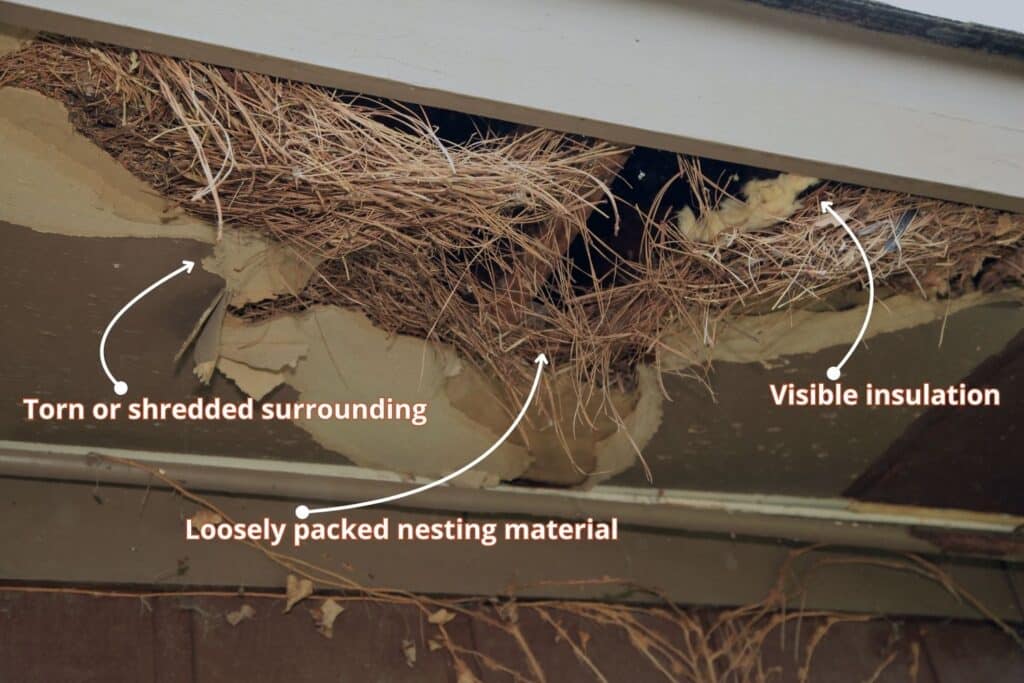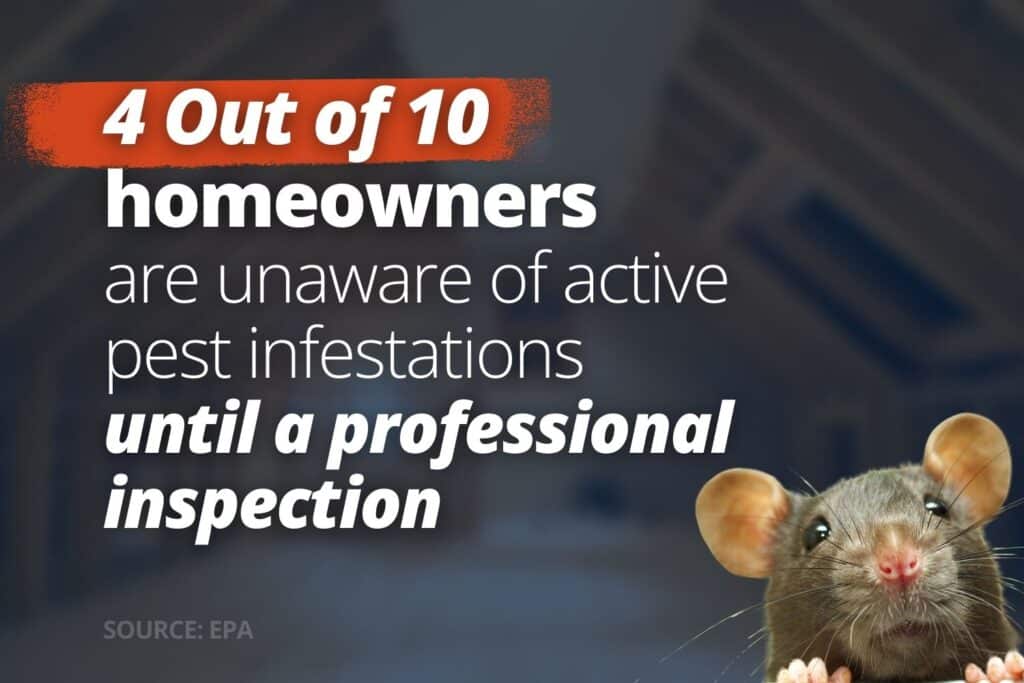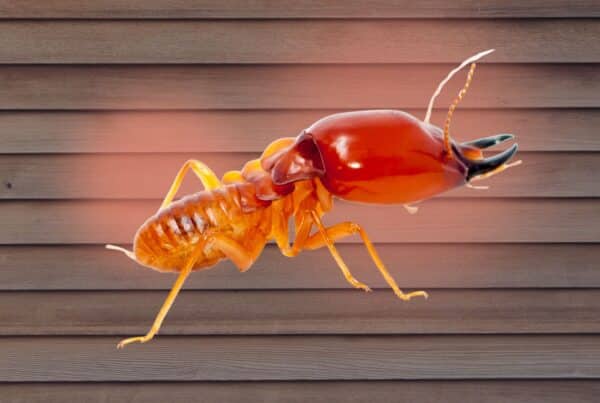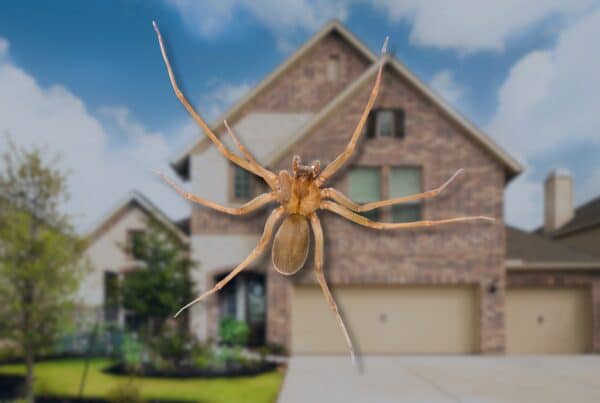In this guide, we’ll show you what a rats nest looks like, the common places they hide in Texas homes, and how to act quickly before serious damage happens.
Rats are great at hiding. In most homes, you won’t see the rat before you see the mess they leave behind. And one of the biggest signs you’re not alone? The nest.
Rats don’t just wander through homes or businesses randomly. They build nests to stay safe, warm, and close to food. If one nest is spotted, there’s a good chance others are nearby, and a bigger infestation may already be growing.
What a Rats Nest Looks Like
A rats nest usually looks like a pile of shredded or loosely packed material. At first glance, it may look like nothing more than old insulation or junk. But if you look closer, nests often include:
- Torn paper or cardboard
- Fabric scraps
- Shredded plastic or foam
- Bits of insulation
- Food wrappers
- Droppings and urine stains
Rats build nests in a way that helps them stay hidden, even in well-lit areas. Most nests are tucked behind or inside walls, cabinets, attics, or appliances. They’re usually about the size of a football or larger.
You may also find nesting tunnels or multiple chambers if the infestation has been going on for a while.

Fresh vs. Old Rats Nest
If a nest is still active, you may notice:
- New droppings nearby
- Grease marks or rub stains on surrounding surfaces
- Scattered food crumbs or chewed packaging
- A strong, musky odor
Old or abandoned nests may still pose a health risk due to contamination, especially if there are urine stains or dried droppings present.
According to the CDC, rodent droppings and urine can spread harmful viruses and bacteria, even after rats are gone.
Where Rats Build Nests in Homes
Rats look for quiet, hidden areas where they can stay warm and close to food and water. In homes across Texas, we often find nests in:
1. Attics
Insulation provides ideal nesting material, and attics are rarely disturbed. Look for signs near vent openings, rafters, or behind stored boxes.
2. Wall Voids
Rats can enter through tiny holes and build nests inside walls. You may hear scratching sounds or notice chewed drywall or baseboards nearby.
3. Crawlspaces
Dirt floors and cluttered crawlspaces are perfect nesting zones. Rats often burrow into insulation or nest under HVAC units or piping.
4. Behind Appliances
Kitchens offer easy access to food, which is why rats love nesting behind refrigerators, dishwashers, or stoves.
5. Garage Clutter
Piles of boxes, storage bins, or unused furniture create ideal cover. If your garage isn’t sealed well, it’s an easy entry point for rodents.
6. HVAC Closets or Laundry Rooms
If there’s moisture and warmth, rats can take advantage. Nests may be built behind water heaters, washers, or ductwork.
Outdoor Nesting Sites Around Texas Homes
Rats often start outside before moving in. Common exterior nesting areas include:
- Wood piles
- Overgrown shrubs or ivy
- Under decks or porches
- Compost piles
- Sheds or detached garages
- Gaps near AC units or foundation vents
A study by the University of Florida found that roof rats commonly build nests in trees or shrubs, then enter homes through roof lines or attic vents.
Removing outdoor attractants is one of the best ways to keep rats from building nests near your home.
What Attracts Rats to Nest in Homes?
Rats are opportunistic. They’ll move in wherever they find:
- Food scraps or open pet food
- Leaky pipes or water bowls
- Cluttered storage
- Insulation or nesting material
- Easy access through vents or openings
In Texas, where mild winters allow rat activity year-round, nests can go unnoticed for months. That’s why regular home maintenance and professional inspections are so important.
How to Tell If You Have a Rats Nest
In one study, over 40% of homeowners with active rodent infestations were unaware of it until a professional inspection. If you look for these signs near walls, attics, or dark corners, you can avoid being one of them:
- Piles of shredded material (paper, plastic, or insulation)
- Small dark droppings nearby
- Strong, musty or ammonia-like smell
- Noises at night like scratching or scurrying
- Grease marks or gnawing near baseboards or wiring
- Disrupted insulation or chewed ductwork
If you find more than one of these signs, don’t wait to investigate further. Rats reproduce quickly. A single nest can turn into a full infestation in a matter of weeks.

What to Do if You Find One
1. Don’t Touch It Bare-Handed
Rats nests are full of bacteria, fleas, and parasites. Use gloves and a mask if you need to handle the area.
2. Don’t Assume It’s the Only One
Rats often build multiple nests, especially if the infestation has been going on for more than a few weeks.
3. Call a Professional
A licensed pest control technician can locate additional nests, safely remove them, and eliminate the source of the problem.
4. Sanitize the Area
Even if the nest is gone, the contamination remains. Use a disinfectant rated for rodent cleanup, and seal off any gaps or entry points nearby.
5. Address Food and Clutter
Store food in sealed containers, clean up crumbs quickly, and reduce clutter inside and out.
Related Questions
What’s the difference between a rat and mouse nest?
Rat nests are typically larger and made from coarser materials like insulation, cardboard, and twigs. Mice, on the other hand, prefer softer materials such as fabric, paper shreds, or pet fur. Our rodent control services can help you spot the difference and act fast.
Is it possible to have a nest and not hear anything?
Absolutely. Rats are most active at night, and they may go unnoticed in large homes or attics until the infestation grows.
Will traps alone remove a nest?
Traps may catch one or two rats, but they don’t solve the core issue. Nests can stay hidden, and without sealing entry points or removing food access, new rats will move in.
When to Call a Professional
You don’t have to see a rat to have a rat problem. If you’ve spotted shredded debris in hidden corners, smelled strong odors, or heard scratching sounds at night, a nest may already be in place.
At Grand Slam, we locate nests quickly, clean them up safely, and use proven treatments to keep rats from coming back.
Our team also inspects the full home and property so you don’t miss hidden entry points or damage.
Final Thoughts
Rats nests are a warning sign that no one can afford to ignore. Finding one early helps you prevent property damage, health risks, and costly infestations.
If you think rats have moved in, don’t wait to act. Grand Slam Pest helps Texas homeowners stop the problem at the source.
Schedule your rodent inspection today and take back control of your home before things multiply.



